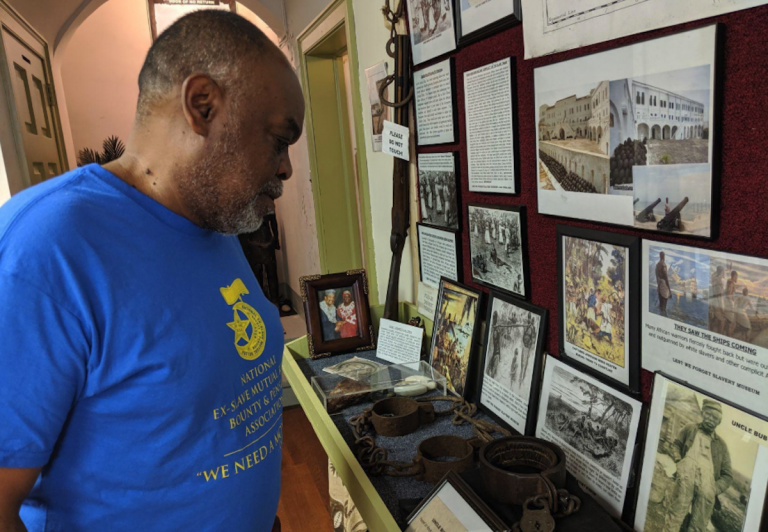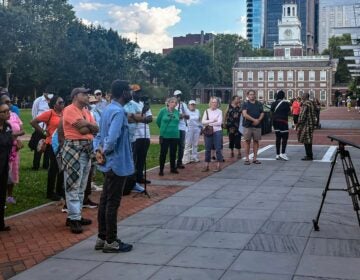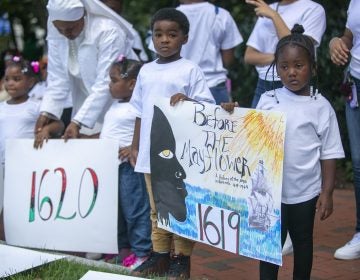Slavery and Philly: Since arrival of first enslaved Africans, deep scars exists here, across Commonwealth
Enslaved Africans were present in the region well before William Penn planted England’s flag here in 1681.

'All this stuff touches home. It doesn’t go back that far,' says Germantown resident Mark Keenheel as he looks at items in the Lest We Forget Museum of Slavery recently in August. (Michael D'Onofrio/The Philadelphia Tribune)
This story originally appeared on The Philadelphia Tribune.
A native of the Germantown neighborhood, Mark Keenheel stepped into the Lest We Forget Museum of Slavery recently for the first time.
He came face to face with the implements of slavery once used to keep Africans in bondage for hundreds of years — iron shackles, whips, slave tags, branding irons.
Keenheel said he has traced his genealogy to his great-great-grandfather Zedediah, born in 1838, and great-grand father, Simon, born in 1860, both enslaved in Bamberg, South Carolina.
“All this stuff touches home,” he said while looking at the artifacts. “It doesn’t go back that far.”
Faruq Ghaffar, who traces his roots to Lumberton, North Carolina, where his great-great grandmother was enslaved, said in a phone interview that the journey of Africans from bondage to freedom “has been a great blessing from God.”
To highlight the struggles and journey of African Americans, Ghaffar said the 400 Years Coalition, which he heads, has worked with groups, activists and historians throughout the year to mark the 400th anniversary of the first documented ship carrying enslaved Africans to North America.
The scars of slavery remain for both African Americans — poverty, gun violence and poor schools that impact Blacks at higher rates than other demographics in the city — and whites, Ghaffar said.
“Things are clocked into us from slavery,” he said.
Molefi Kete Asante, professor and chairman of the Africology and African American Studies at Temple University, said in an email that the anniversary “represents a mighty narrative of resilience, resistance, and restoration of the African spirit since the first 20 Africans stepped onshore in Point Comfort, Virginia, in 1619.”
“Nineteen years later, Africans entered what became the Pennsylvania colony,” he added.
With the anniversary fast approaching, Keenheel said he wasn’t exactly sure how to feel.
“It’s complicated,” he said. “It’s a complex issue.”
Arrival in Pennsylvania
Enslaved Africans were present in the region well before William Penn planted England’s flag here in 1681.
As far back as 1639, Africans were present in the region during the days when the Dutch and Swedes ruled the Delaware River and the land around it.
In 1684, a ship named the Isabella anchored in Philadelphia’s port with approximately 150 captured Africans, which is considered the first shipment of enslaved Africans to arrive in the city after Penn’s arrival.
Few port records survive to document the early trafficking of enslaved Africans to Pennsylvania (which included Delaware until 1776). Instead, newspapers and other records sketch an incomplete story about the slave trade in the region, but those only date back to 1720.
Between 1718 and 1804, at least 10 vessels that participated in the trans-Atlantic slave trade docked in Pennsylvania ports carrying an estimated 1,000 enslaved Africans, according to the online database Slave Voyages.
Another 103 vessels carried more than 1,400 enslaved Africans from South America, the Caribbean and other American colonies to Pennsylvania between 1709 and 1776, according to the database.
The Slave Voyage database is in no way a complete list, said Gregory O’Malley, a historian working on the project.
“We know from other sources that enslaved Africans were [in Pennsylvania], we just don’t know how they got there or when,” he said. “That’s true in a lot of places. … We just don’t have the systematic records.”
Nonetheless, the enslavement of Africans in Pennsylvania followed a pattern similar to those established in older settlements, Asante said, but their numbers remained less than in the other colonies, including Virginia, North Carolina and Maryland.
Pennsylvania received deliveries of enslaved Africans primarily from the West Indies and Charleston, South Carolina, with shipments peaking between the late 1730s and 1750s, according to historians.
Blacks in Pennsylvania were sometimes referred to as “Guineas,” because they were taken from Africa’s Guinea coast, writes local historian Charles Blockson in “African Americans in Pennsylvania: A History and Guide.”
The Dutch and Swedes originally sold slaves from auction blocks in Philadelphia on modern-day Delaware Avenue near Market Street (then called Water and High streets), markets the English later continued to operate, Blockson said in an interview.
Slave owners publicly lashed enslaved Africans at a whipping post nearby at 2nd and Market streets.
The lack of official reports combined with no definite census make it difficult to determine the number enslaved Africans in Pennsylvania during the colonial era, writes historian Edward Raymond Turner in “The Negro in Pennsylvania: Slavery-Servitude-Freedom 1639-1861.”
But an estimate in 1721 numbered enslaved Africans in Pennsylvania between 2,500 and 5,000, according to Turner.
By the 1790 federal census, the number of slaves in the state totaled 3,737, or about 0.9% of the state’s population. (Free Blacks in the state numbered 6,537.) In the largest slave-holding state of South Carolina, enslaved Africans made up 43% of the population that year.
Different work
In Pennsylvania, enslaved Africans were used in agriculture, metallurgy and felling trees in the forests to make room for farm lands, Asante said. In the towns and cities, Africans were used for physical labor, including shoemaking, shoveling, cooking and carpentering.
Unlike the plantation colonies of the South, Philadelphia merchants in some cases sought enslaved children to suit the preference of city dwellers seeking domestic servants, O’Malley said.
The enslaved children, O’Malley said, could better assimilate in the urban environment compared to the manual, rote labor of work on plantations. Many also were trained as artisan craftsmen, including bakers and jewelers.
“Bringing in enslaved people at a young age, they could train them to a profession as a way that they would a white apprentice,” O’Malley said.
“But, of course, that white apprentice, once they go through that period of apprenticeship, then becomes a competitor,” he added. “An enslaved worker trained in the craft has the advantage that they never leave.”
Philadelphians also preferred enslaved women to help with domestic tasks, said Erica Dunbar, the Erica Armstrong Dunbar Charles and Mary Beard Professor of History at Rutgers University in New Jersey.
“Women were, in their minds, well suited for the domestic tasks that they needed completed,” she said.
The fight for abolition
The first known “anti-slavery protest” was led by white men in Philadelphia.
In the Dutch Quaker and German Mennonite community in modern-day Germantown, four white men laid out objections to slavery in a petition in 1688. They called on their fellow slave-holding Quakers to abolish the practice.
The modest wooden table where the men wrote their petition remains on display inside the Mennonite Meeting House in Germantown.
The Quakers ultimately rejected the petition and continued to buy, sell and trade enslaved Africans, said historian Craig Stutman recently as he stood beside the approximately 400-year-old table.
Quakers wouldn’t abolish slavery in their community until the 1770s. But Stutman said the petition by this original group of “social-justice oriented Quakers” represented a seminal moment in the white abolitionist movement.
“It really lays the groundwork for other protesters or dissenters throughout the 18th century,” he said.
That anti-slavery protest marked “one of the enlightened moments in Pennsylvania’s history,” Asante said.
However, Asante added that Africans were nonetheless “caught in the cauldron of ethnic and religious tensions among the Europeans and nearly a hundred years later were held in bondage by George Washington when he became president residing in Philadelphia.”
In this early colonial period, Pennsylvania’s Assembly passed a series of duties to restrict trafficking in the slave trade, although overseers in England repealed much of the legislation.
While some historians say the state’s opposition to slavery was more ethics than economics, O’Malley said no amount of ethics prevented Pennsylvanians from participating in the slave trade, including the abolitionist Quakers.
“There are significant numbers of slaves in the [Pennsylvania] colony, too, and there doesn’t seem to be much moral stigma attached to it in the prior decades,” he said.
In 1780, during the Revolutionary War, Pennsylvania became the first state to pass a law abolishing slavery.
However well intentioned it might have been, the Act of Gradual Abolition proved ineffectual at preventing some abuses, including the trafficking of slaves.
The law was later strengthened in the courts as abolitionists promoted its enforcement.
But even during the 19th century when Pennsylvania had a “relatively substantial abolitionist segment,” the state’s white population was no different than Southern racists when it came to the presence of free Blacks and slaves, Blockson wrote in “African Americans in Pennsylvania: A History and Guide.”
“The majority of white Pennsylvanians were simply apathetic about the plight of Blacks,” Blockson wrote.
Slavery and Philadelphia: Forever linked
As the birthplace of America and the nation’s first capital, Philadelphia is inseparable from slavery, civil rights attorney Michael Coard said.
“When you talk about slavery, you’re talking about Philadelphia because Philadelphia is the center of the American universe,” he said.
As African Americans enter the fifth century since bondage was introduced here, Coard said it is up to the next generation to determine how the Black experience develops and solves the issues of the day, including mass incarceration, police brutality and voter disenfranchisement.
“We as adults, we as elders will provide [the next generation] with the history, we’ll provide them with the information, we’ll provide them with the facts,” Coard said, “but then we’ll turn it over to them to do what needs to be done.”
“Maybe the next generation might ratchet things up from a moderate approach to an activist approach to a revolutionary approach,” he added. “I’ll leave that up to them.”
WHYY is your source for fact-based, in-depth journalism and information. As a nonprofit organization, we rely on financial support from readers like you. Please give today.




